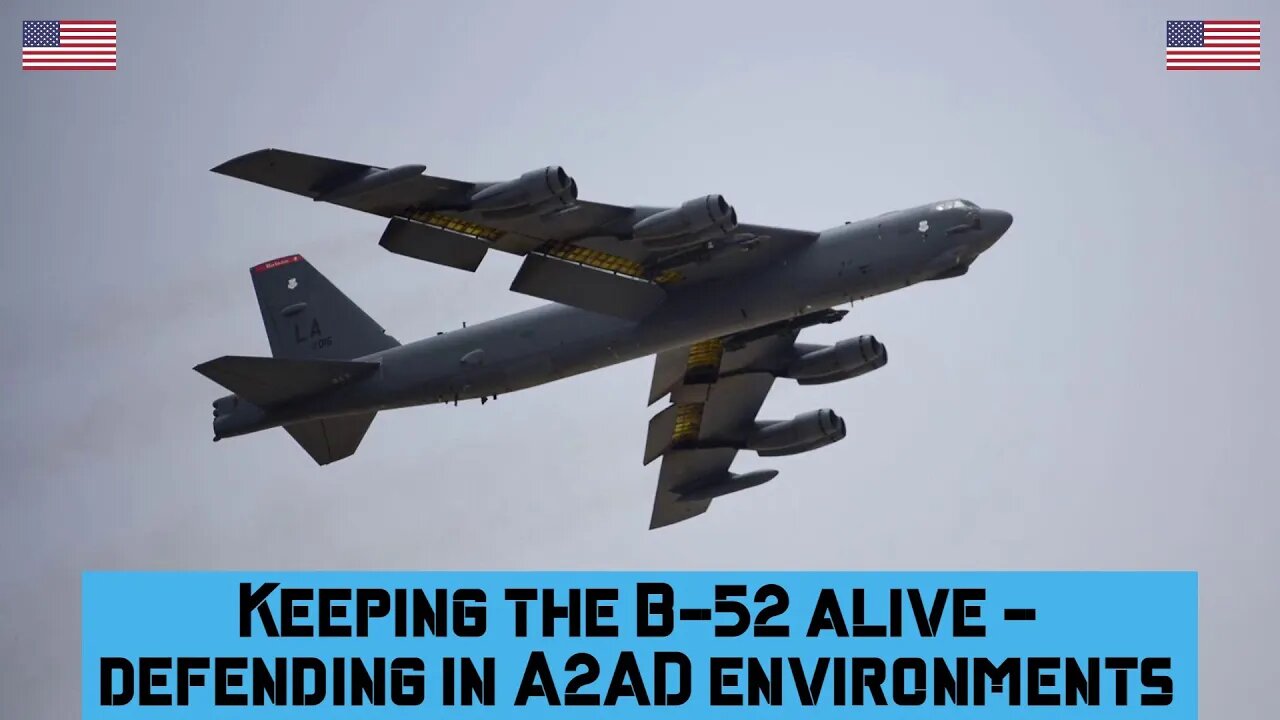Premium Only Content

Keeping the B 52 alive - defending in A2AD environments #b52 #b52bomber
Connect with us on Facebook: https://www.facebook.com/profile.php?id=100087951995959
Twitter: https://twitter.com/shieldwall_d
Keeping the B-52 alive - defending in A2AD environments. One of the primary ways to defend B-52 bombers during operations is through the use of fighter jets as escorts. These fighter jets can provide protection for the bombers by intercepting incoming threats and engaging in air-to-air combat.
Another way to defend B-52 bombers is through the use of surface-to-air missiles (SAMs). These missiles are typically mounted on ground-based platforms or on ships and are used to intercept and destroy incoming aircraft or missiles.
B-52 bombers can also be equipped with electronic countermeasures (ECM) systems to defend against radar-guided missiles. ECM systems use a variety of techniques, such as emitting false radar signals or jamming enemy radar, to confuse or deceive incoming threats.
Another option for defending B-52 bombers is the use of air-to-air missiles (AAMs). These missiles are typically carried by fighter jets or mounted on the bombers themselves and are used to engage and destroy enemy aircraft.
B-52 bombers can also be protected by the use of air defense artillery (ADA) systems. These systems, which include guns and cannons, are typically mounted on ground-based platforms and are used to engage and destroy incoming aircraft or missiles.
Another method of defending B-52 bombers is through the use of chaff and flare dispensers. These dispensers release small pieces of reflective material or flares to confuse or deceive incoming missiles, making them more difficult to track and intercept.
The use of early warning and control systems, such as radar and satellite-based systems, can also be effective in defending B-52 bombers. These systems can detect incoming threats at long ranges and provide timely warning to the bombers and their escorts, allowing them to take evasive action or engage the threat.
Network-centric warfare (NCW) systems can also be used to defend B-52 bombers. NCW systems integrate sensors, communications, and weapons systems to provide a comprehensive picture of the battlefield and enable real-time coordination and decision-making.
The use of stealth technology can also be effective in defending B-52 bombers. Stealth technology, such as radar-absorbing materials and low observable design features, can make the bombers more difficult to detect and track by enemy radar.
Another option for defending B-52 bombers is the use of cyber capabilities. These capabilities can be used to disrupt or deceive enemy communications and weapons systems, making it more difficult for them to target the bombers.
The use of decoys and other deception techniques can also be effective in defending B-52 bombers. These techniques, such as the use of dummy aircraft or fake electronic signals, can be used to confuse or mislead enemy forces, making it more difficult for them to identify and target the bombers.
The use of electronic warfare (EW) systems can also be effective in defending B-52 bombers. EW systems use a variety of techniques, such as jamming and spoofing, to disrupt or deceive enemy communications and weapons systems.
Another option for defending B-52 bombers is the use of ground-based air defense systems, such as anti-aircraft guns and missiles. These systems can be used to engage and destroy incoming aircraft or missiles at long ranges.
The use of stand-off weapons, such as cruise missiles and drones, can also be effective in defending B-52 bombers. These weapons can be launched from a safe distance and used to engage and destroy enemy assets, making it more difficult for them to target the bombers. Until next time, take care.
====================================
We appreciate all of our viewers and supporters. Thank you.
====================================
Fair use is the right to use a copyrighted work under certain conditions without permission of the copyright owner. The doctrine helps prevent a rigid application of copyright law that would stifle the very creativity the law is designed to foster. It allows one to use and build upon prior works in a manner that does not unfairly deprive prior copyright owners of the right to control and benefit from their works. Together with other features of copyright law like the idea/expression dichotomy discussed above, fair use reconciles the copyright statute with the First Amendment.
====================================
-
 11:09
11:09
Nikko Ortiz
2 days agoMost Painful TikTok Clips... Part
93.7K27 -
 1:13:11
1:13:11
Man in America
15 hours agoDr. Ealy: How Ancient Bloodlines Turned Medicine into a WEAPON Against Humanity
85.9K81 -
 5:35:39
5:35:39
SpartakusLIVE
10 hours agoLAST DAY of BATTLEFIELD 6 || WZ - BF6 - PUBG
43.6K -
 5:28
5:28
Zach Humphries
1 day ago $10.86 earnedMAJOR STELLAR XLM PARTNERSHIP ANNOUNCED!
43.6K3 -
 4:51:51
4:51:51
MattMorseTV
12 hours ago $24.28 earned🔴Gaming Sunday🔴
75.6K12 -
 24:24
24:24
Jasmin Laine
13 hours ago“Their BIGGEST Mistake Yet”—U.S. Officials TORCH Carney in Brutal Report
63.5K66 -
 5:15:53
5:15:53
Rallied
11 hours ago $11.11 earnedWARZONE SOLO CHALLENGES ALL DAY
56.6K -
 2:00:33
2:00:33
Joker Effect
9 hours agoSoo @MrBeast charity, is it legit? XenaTheWitch got attested? Lets talk about it! HOW TO GO VIRAL.
45.9K5 -
 27:01
27:01
TheRoyaltyAutoService
17 hours ago $4.97 earnedAnother Shop Replaced The Timing Belt & Fuel Injectors On This Honda Pilot… Now It Has No Power!
52.4K3 -
 10:14:25
10:14:25
GritsGG
19 hours agoRanked Crim 2! Most Wins 3390+ 🧠
93.7K2